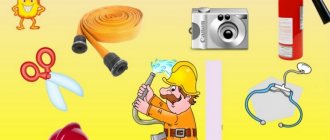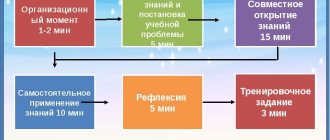Summary of an open lesson on cognitive activity in the preparatory group of a preschool educational institution
municipal budgetary preschool educational institution
city of Rostov-on-Don “Kindergarten No. 317”
Summary of the lesson “History of the creation of watches” with children of the preparatory group
(cognitive development)
Prepared by:
Gladkova Yu.A.,
teacher
MBDOU No. 317
2019
Purpose: Formation
children's ideas about watches, the history of watch creation.
Tasks:
Educational. To acquaint children with the history of clocks, expand their knowledge about clocks (introducing the concepts of “living clocks”, modern clocks, sun clocks, sand clocks, electronic clocks, fire clocks, mechanical clocks).
Developmental. Develop research interest, curiosity, self-control skills, creative imagination and logical thinking.
Educational. Cultivate the ability and ability to save time.
Materials and equipment:
A computer, a multimedia board for demonstrating a presentation, an audio recording of sounds, logo tablets for each child, insert cards for the logo tablets, a model of a sundial, various types of clocks (hourglass, electronic, mechanical), a bell.
Progress of the lesson:
Educator:
Good afternoon I'm very glad to see you guys! Stand in a circle and let's get acquainted. My name is Yulia Agadarovna, I work as a teacher in the Golden Cockerel kindergarten.
Exercise “Give a smile to a friend”
Educator:
I’m in a very good mood today, because in the morning, when I went to visit you, the bright sun came out like this
(draws the children’s attention to the picture)
and gave me its gentle smile. And I wanted to share with you my sunny smile and my good mood. I have a magic bell in my hands, it will help us convey a smile and a good mood to each other. Let's say these words: “We will look at each other - give a smile to your friend.”
(The teacher begins, then the children, smiling at each other, pass the bell and say: “Alenka, I give you my smile and good mood”...)
Educator:
The smile has returned to me again! And we are all in a good mood!
And this morning I heard many different sounds, and I also wanted to give them to you. Want to listen? Then listen.
(The recording of sounds is turned on - rooster crow, birds singing, cuckoo, alarm clock ringing, chimes striking, clock ticking).
Educator:
What sounds did you hear?
(children call)
Teacher:
What a variety of sounds there are. What do you think these sounds have in common?
(children's answers)
If the children find it difficult to answer a question, the teacher begins to reason out loud himself.
- You said it right, these sounds wake us up in the morning. They act as an alarm clock. What is an alarm clock?
(children's answers)
- Yes, this is a clock that is wound in the evening so that it wakes us up in the morning. And today we will talk about watches.
Educator:
Why does a person need a watch?
(Children's answers: to know what time it is. To know when to wake up in the morning, to go to kindergarten. To not be late for the train, bus, etc.)
Educator:
What do you think would happen if no one had a watch?
(Children’s answers: you can be late for work, school, kindergarten, store, birthday, etc.)
If the children find it difficult to answer a question, the teacher begins to reason out loud himself.
Educator:
Of course, in our time it is rare to meet a person, even a schoolchild, who does not have a watch. Where can I see the clock?
(Children's answers: clocks on city buildings, on the streets, train stations, in every apartment)
It is simply impossible to imagine modern life without watches. But there was a time when there were no clocks and our ancestors could only dream about it.
How do you think people lived without watches before? How was time determined?
(children's answers)
Do you want to know how watches came to be? Then I propose to go to the distant past. To do this, you need to close your eyes and say the magic words:
One, two, three, turn around yourself,
Find yourself in the distant past.
Open your eyes. So you and I have found ourselves in the distant past. But before we continue, let's warm up!
Physical education minute:
The mouse climbed for the first time
See what time it is?
Suddenly the clock said: “Bang!”
The mouse rolled head over heels!
Educator:
Sit down on the chairs. It turns out that there were clocks before, but in those ancient times they were different. And I have a surprise for you (a box with a watch). And you will see what lies in it a little later.
Conversation while watching the presentation.
Slide 1. Live clock.
Educator:
Have you heard about “live clocks”? Guess what they might be?
(children's answers)
Educator:
You will probably be surprised, but you have already seen “live clocks” and know them well. This clock walks importantly around the yard, flaps its wings and, flying up onto the fence, shouts “cuckoo.” Did you find out who it is? Yes, it turns out that a rooster is also a “clock”. He tells everyone that morning has already come! The rooster crows for the first time when the sun has not yet appeared, but has only released its first ray.
Educator:
And singing birds can also be “living clocks” in spring and summer.
How do you think nightingales, larks, and finches can help us tell time? (children's answers).
That's right, they sing in the morning. The sparrow starts tweeting at 6 am.
Educator:
People also knew other living clocks - these were plants. Try to guess how flowers can tell us what time it is? They don’t have a mouth, a tongue, they can’t speak in words. But they “speak” differently. How?
(children's answers)
The clock opens its petals and closes them strictly at a certain time. As if on command. And they never get confused! For example, dandelions open at 5 am sharp.
Exercise “Good - Bad”
Do you think such watches are convenient for people? Why? Why are they inconvenient?
(children’s answers:
inaccurate...)
Educator:
You said it right.
The good thing is that live clocks are available to everyone (you don’t need to buy them in a store), they never lose time, they are beautiful and pleasing to the eye, etc.
The bad thing is that you cannot take a “live clock” with you into your room; there are no such clocks in cities. And it is difficult to determine the exact time by the crowing of a rooster. Either a rooster falls from its perch in a dream and starts screaming prematurely, or the fox gets scared and starts screaming...
And a man came up with a more reliable watch.
Slide 2.
Sundial
Teacher:
One day a man noticed a shadow that was falling on the ground from a tree. He took a closer look and noticed that the shadow did not stand still, but moved after the sun. A man watched a shadow run around in a circle and came up with a clock: he dug a pillar into the ground, and around the pillar he drew a circle, dividing it into parts. Each part was equal to one hour. The sun rose, and the shadow of the pillar moved slowly in a circle, marking hour after hour. What do you think the name of such a watch was?
(Children's answers: sunny)
That's right, such a clock was called a sundial.
Experience with watches. Children get up from their chairs and stand around the table.
There is a model of a sundial on the table. Using a flashlight, invite the children to conduct an experiment: The sun (the flashlight is on) moves in a circle and the shadow of the stick shows the time.
After observing the sundial in the morning and evening, draw a conclusion: when is the shadow of the stick longer - in the morning or in the evening? (In the morning when the sun rises)
Educator:
Do you think it is always possible to tell time using this watch?
(Children's answers: on a cloudy, rainy, gloomy day it is difficult to do this because there is no sun).
Children sit on chairs.
Slide 3. Water clock
Educator:
A little later, people came up with a water clock that did not depend on sunlight. Water was poured into a tall and narrow glass vessel with a hole at the bottom. Drop by drop it flowed out of the hole. The water in the vessel became less and less. Marks were made on the walls of the vessel. They showed how much time had passed since the moment water was poured into the vessel. When the vessel was empty, the man assigned to the clock filled it again.
Educator
: What do you think people called these watches?
(Children's answers: Water, water)
Educator
: Such watches also turned out to be inconvenient for humans. They had to constantly add water. What kind of watch does a water clock look like?
(Children's answers: To the sand ones).
Educator:
And then the man replaced the water clock with an hourglass.
Slide 4. Hourglass
Educator
: Sand was poured into the vessel. Through a narrow hole, sand poured into another part of the vessel. This is how people knew the time. These ancient clocks have survived to this day. Maybe some of you have seen such a watch? Where are they used?
(Children's answers: in the pool, in the clinic)
Educator:
Do you think these watches are comfortable?
(Children's answers: They are not convenient, because they cannot be put in a pocket and taken on a trip.)
Slide 5. Fire clock
Educator:
At the same time as the hourglass, the fire clock also appeared. There are stripes drawn on the candle. How much wax melts into strips, so many hours have passed. But they weren't used for long.
Why do you think people stopped using candles as clocks?
(Children's answers: If the candle falls, a fire may occur; the light in such a clock could be blown out or extinguished by wind or rain.)
Slide 6. Mechanical watches
(using a mechanical watch model)
(Children can get up from their chairs)
Educator:
And a man came up with a more reliable watch. They placed a spring inside them, twisted it, and to prevent it from unwinding, they attached a gear wheel to it. It clings to another wheel and turns it. The second wheel turns the arrows. The clock initially had one hour hand. Later a minute hand appeared.
But mechanical watches need to be wound constantly. I forgot to wind my watch and it stopped. What watches don't need to be wound? They run on batteries. They don't even have arrows, but numbers glow on the screen.
(
Children’s answers: electronic, quartz)
Game “Name it correctly”
Nowadays there are many different watches.
- A clock that stands on the floor is called a “floor clock.” They are very large and heavy, you can’t even move them to another place.
- What is the name of the clock that hangs on the wall? (wall-mounted).
- The watch that is worn on the hand is called - (wrist).
- We are woken up in the morning by a clock called - (alarm clock).
- There are also clocks on the towers. They are called... (tower). In our country, the most important tower clock is on Red Square. They are called "chimes".
- A watch that is carried in a pocket... (pocket).
Slide 7.
Educator:
You guys see what a difficult journey the hours have gone through. And all this was invented and made by man. And watchmakers - watchmakers - began to invent clocks in the form of boxes, turrets, gazebos, and taught clocks to play music.
Let's turn into a watch for a moment.
(music turns on, children stand in a circle)
Rhythmic pause to the music “Clock” from the cartoon “Fixies”.
Educator
: While you and I were dancing, we didn’t notice how we returned to our time, to our kindergarten
Now let’s sit down at the table where an envelope has been prepared for each of you. Look what's in them? You need to assemble the picture correctly.
And now we will try to solve several problems on such a tablet (logo tablet with task cards). 3 minutes are allotted to solve each problem. To find out about time we will use a clock. What are their names? (sand). Look carefully at the task card. You see six images on the main field. They are marked with circles in the color of the chips on the tablet and six images in a vertical row on the right. Select one image on the main field, find a chip of the corresponding color and move it to the correct answer in the vertical row. To check the result, turn the card over. The colors of the chips on the tablet and the circles on the card must match.
- “Find a place for the clock.” Determining the type of watch by its characteristic features. Finding a place to place them.
Educator: Look at the card. What do you think, where and what kind of clock should be located? Now, to note the time, turn the watch over with the sand facing up and you can begin.
Children complete the task.
- "How they built the house." Determination of the time sequence in the stages of building a house, comparison with numbers.
Educator: where do you think construction begins? In what order are they conducted? And again, let's turn the clock over, mark the time and begin.
Children complete the task.
You are all great fellows!
Educator:
I invite everyone to the circle - our journey has come to an end.
What new did you learn today? (children's answers)
Guys, thank you all for your participation! I liked that you were all active, I liked the way you answered and completed tasks. Time does not stand still, it moves very quickly, and maybe one of you, when you grow up, will become a watchmaker and invent a new watch, and they will be called “cosmic”.
Please tell me what is the name of the person who makes or repairs watches?
And I recently tried to become a watchmaker and made this watch for you, as a souvenir of our meeting!
Theme: “Journey to the City of Masters”
Goal: Continue to develop interest in people, consolidate children’s knowledge about the senses, their role in a person’s perception of the world around them.
Tasks:
Correctional and educational:
- generalize children’s existing knowledge about the functions of the senses;
- clarify the meaning of the senses for a person when he perceives the world around him;
- develop the ability to analyze data obtained through experimentation;
- discuss issues of sensory organ hygiene.
Corrective and developmental:
- develop conversational speech using high-quality adjectives, replenish the vocabulary with phrases “organ of hearing, organ of vision, auricle, membrane, touch”;
- develop tactile, auditory, gustatory, visual sensations;
- develop quick thinking and creative imagination;
- expand your horizons.
Correctional and educational:
- cultivate a caring and caring attitude towards your body;
- Cultivate curiosity and the ability to listen carefully.
Methods and techniques:
- visual (show, demonstration);
- verbal (conversation, literary expression, logical reasoning, question - answer);
- gaming (didactic games, surprise moment, finger play;
- practical (drawing, exercises, experimentation, introspection).
Preliminary work:
- conversation about the senses of animals and humans;
- conversation on the topic “Different professions are important”;
- conversation on the topic “Vision”;
- conversation on the topic “Our hands”;
- reading fiction: “What crafts smell like”, K. I. Chukovsky “Moidodyr”, “Doctor Aibolit”, A. Barto “Glasses”;
- plot-based role-playing game “Hospital”;
- learning a set of exercises for the eyes;
- cycle of educational situations on valeology (sense organs)
- viewing educational drawings;
- learning didactic and outdoor games.
Health saving technologies:
- breathing exercises;
- gymnastics for the eyes;
- back massage;
- games with speech accompaniment.


